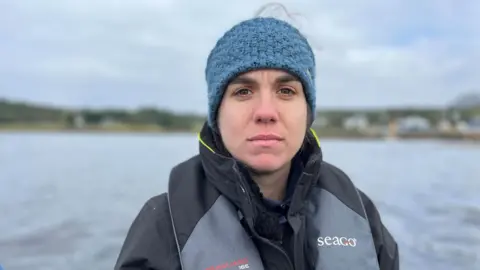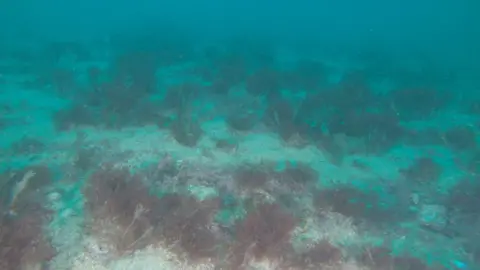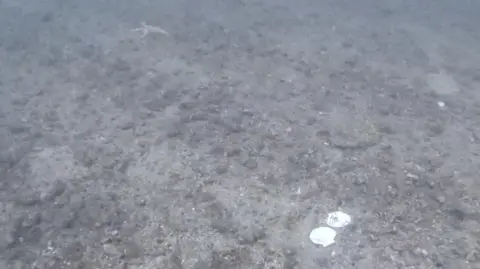Seabed still being damaged in protection zones, campaigners warn
 BBC
BBCEnvironmental groups say large parts of Scotland’s sensitive seabed are still not being protected - 10 years after new laws were introduced.
Marine Protected Areas (MPAs) were created around the country’s coastline in 2014 but fishing has still not been restricted in more than half the sites.
Campaign group Open Seas has shown BBC Scotland News fresh evidence of damage being caused to a protected area near Rum in Lochaber by dredging, which remains legal in that area.
The Scottish government says introducing fishing restrictions is "a complex and challenging process".
The legislation, which was passed 10 years ago, created 30 MPAs around Scotland - including around the Summer Isles and the cliffs of east Caithness.
They were meant to protect, restore and - where possible - enhance Scotland’s marine environment by introducing limits on activities which could damage habitats, such as certain types of fishing.
Campaigners said they were necessary because the seabed had suffered from centuries of overfishing and pollution.
Restrictions on scallop dredging and prawn trawling required additional legislation which ministers promised to introduce in two stages.
But the first stage, in 2016, proved controversial and the Scottish government has delayed introducing fishing bans for the rest of the MPAs.
It means 60% of MPAs still have no protection from damaging fishing methods like trawling and dredging.
Environmentalists say that makes the MPAs nothing more than a line on a map.
 Open Seas
Open Seas OpenSeas
OpenSeasOpens Seas recently took me to the Small Isles MPA which covers the seas around Rum and Canna.
On the very first deployment of an underwater camera they observed parallel lines on the seabed which are created when a dredger's gear is dragged across it.
That area - off Guirdil Bay on the north coast of Rum - was proposed to have trawling and dredging banned as far back as 2016.
But that ban was never introduced and despite the damage being caused it is still perfectly legal for commercial fishing boats to operate there.
Anna Safryghin, a marine biologist with Open Seas, describes the discovery as "disheartening."
She said: "It's like a barren sea bed with just these lines going straight across."
Anna also spotted broken shells which are a bright white colour.
This, she says, demonstrates that the dredging has been carried out recently, before anything has been able to grow over the top of it.
 Open Seas
Open SeasOpen Seas describes the area around Canna, Eigg, Muck and Rum as some of the most biodiverse seas in Scotland.
The seabed there contains carbon-storing muds, maerl beds and horse mussel reefs, which form part of a rich and complex underwater ecosystem.
But campaigners say fishing methods which drag large nets and equipment along the seabed are causing untold damage.
Open Seas director, Phil Taylor, says the Scottish government has recognised the importance of these habitats by creating MPAs but has not afforded them any protection.
He said: "What we've seen today is that in some places there's an abundance of life and there's an abundance of young fish waiting to come through into the populations above.
"But what we're seeing also is that where these harms are being allowed to occur we're seeing flat monocultures that look like the gravel aisle in a garden centre."
 Open Seas
Open SeasThe Scottish government has promised to consult on further measures for MPAs to meet its conservation objectives.
It has launched a consultation on introducing fishing restrictions in the less controversial offshore MPAs which do not border land and communities.
A spokesperson said: "Ensuring that we develop evidence-based and effective fisheries management measures for the large number of inshore sites is a complex and challenging process.
"Social, economic and environmental impact assessments are currently being undertaken for inshore MPAs ahead of public consultation on the proposals for fisheries management measures. We will consult at the completion of these statutory impact assessments."
Last year, plans for even more restrictive Highly Protected Marine Areas (HPMAs) were scrapped after concerns were raised across Highlands and island communities.
HPMAs would have prevented any form of human or commercial activity from taking place within the zones.
Many creel fishermen and scallop divers support restrictions on larger scale commercial fishing in MPAs.
But the Scottish Fishermen's Federation says there should not be a presumption against fishing within zones as long as conservation objectives can be met.
Chief Executive Elspeth Macdonald said: "Our fishermen depend on healthy, productive seas for their livelihoods, and want to ensure that future generations can do likewise.
"What is key therefore, is achieving the balance between conserving the features in need of protection alongside sustainable use for food production."
